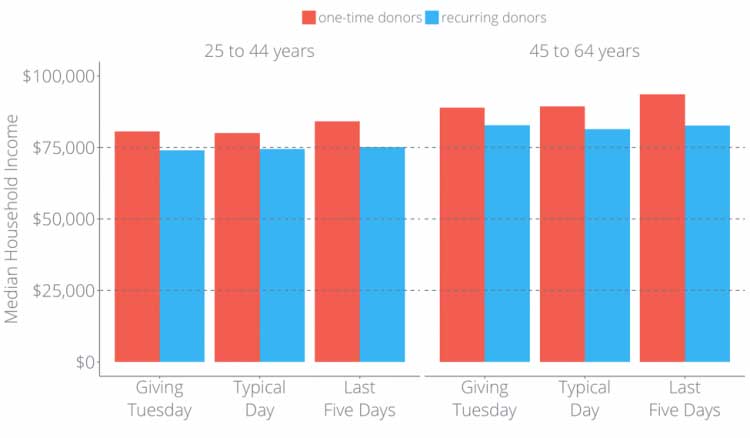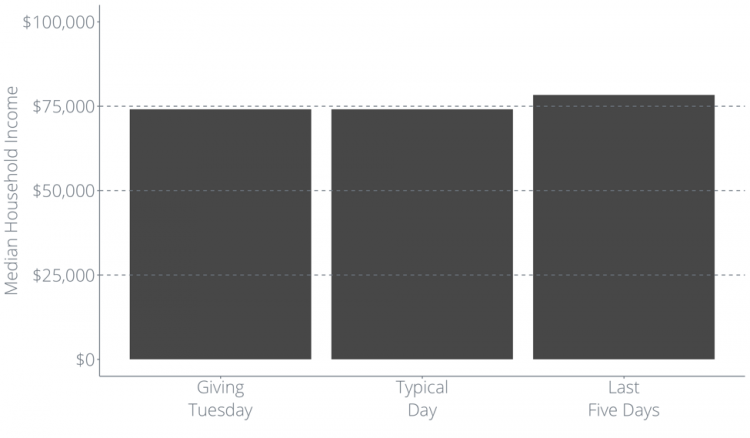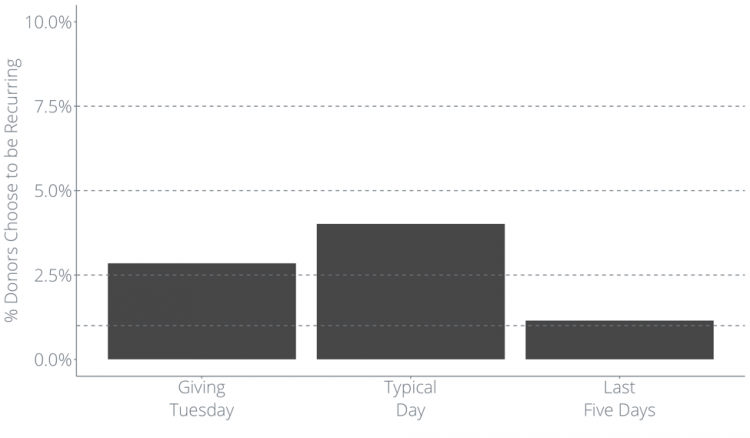Donor Insights You Need to Know for Giving Tuesday

This piece was written by Classy Senior Data Scientist Dr. Page Piccinini.
As nonprofits plan their year-end fundraising strategies, some have voiced a concern about participating in Giving Tuesday and the impact it might have on their larger, year-end goals. Some fear that participating in Giving Tuesday runs the risk of cannibalizing their year-end efforts. This has led to a number of nonprofits opting to skip Giving Tuesday altogether.
However, our own analysis reveals that Giving Tuesday is an incredibly important day, not only for the spike we see in donations, but also for the increase in the number of new and recurring donors.
In this post, we’ll demonstrate the following key findings:
- Giving Tuesday donors are more similar to typical-day donors than donors who give on the last five days of the year
- The main differences between Giving Tuesday donors and donors who give during the last five days of the year are to do with donor demographics and likelihood of becoming recurring donors
- These donor demographic differences are even greater between one-time and recurring donors, where we find that recurring donors have a lower median income, but contribute over five times more to an organization
Let’s dig in!
The Data Set
One way to test whether or not Giving Tuesday really detracts from donations made on the last five days of the year is to look at the donors themselves. Do Giving Tuesday donors belong to similar demographics and take similar actions as donors who give between December 27 and December 31? Or are they somehow different, suggesting that Giving Tuesday taps into a different donor pool than the last five days of the year?
To test this question we looked at donations in a very specific time window: November and December 2017. We wanted to see how Giving Tuesday donors (November 28, 2017) compared to donors who give during the last five days of the year (December 27, 2017 to December 31, 2017) and to donors from the rest of November and December (more typical-day donors). To get demographic information we used public survey data from the American Community Survey (ACS), which provides data points from throughout the United States. We were able to use donors’ zip codes to get summary information about where they were from.
Data Analysis
Usually when people talk about donor demographics they discuss age and gender. However, in this analysis we chose to look at a different variable: median household income [1].
Recently there has been more discussion around attracting and maintaining high net worth donors. High net worth donors also tend to make large donations during the last five days of the year for tax purposes (there is even an IRS tips sheet). So, this was a good demographic variable to see if Giving Tuesday donors and donors who give during the last five days are from the same group.
We decided to limit our analysis to donation page campaigns, since that’s the most commonly used campaign type on Classy’s platform. To look for significant effects we used a statistical method useful for census data called a Tobit model.
Giving Tuesday and Donor Demographics
First, we found that Giving Tuesday donors do differ from donors who give during the last five days of the year. Giving Tuesday donors had lower median household incomes (difference of about $3,700). However, Giving Tuesday donors were not significantly different from typical-day donors in median household income.
These results suggest that Giving Tuesday donors and donors who give during the last five days of the year are actually from different groups, going against the idea that Giving Tuesday detracts from fundraising at the close of the year. In fact, Giving Tuesday donors look much more like donors from a typical day. Giving Tuesday is thus an opportunity to mobilize your typical donor base all on one day.
Giving Tuesday and Recurring Donations
Let’s take a step back from demographics to talk about another topic big on people’s minds during Giving Tuesday: recurring donors. How do recurring donor signups compare between Giving Tuesday donors, typical-day donors, and donors who give during the last five days of the year?
Based on the plot below, Giving Tuesday donors are more likely to become recurring donors than donors who give during the last five days of the year [2]. This supports previous findings that by skipping Giving Tuesday nonprofits risk losing a pool of potential new recurring donors, recurring donors they won’t get during the final days of the year.
Are Recurring Donors Different From One-Time Donors?
We used demographic and recurring donor data to show that there is no evidence that Giving Tuesday donors are cannibalizing fundraising the last five days of the year. While we were looking at demographics though, we wanted to answer an additional question: are recurring donors different from one-time donors? This is interesting because the following two facts seem to conflict:
- Recurring donors are worth over five times more than one-time donors across their lifetime on the Classy platform
- Yet fundraising during the final days of the year is when we see the greatest donation volume, showing higher donation sizes and less recurring plans being started
Where do we see stronger demographic differences: one-time versus recurring, or Giving Tuesday versus the final days of the year?
For median household income, the effect of a donation being recurring is quite large, with recurring donors making roughly $6,100 less than one-time donors. This “median household income effect” is consistent for each of the three time periods analyzed.

What About Age?
One potential issue with the dataset that we used for our analysis is, Classy’s donors from a given zip code may not be a representative sample of people from that zip code. Specifically, Classy’s donors tend to skew younger than median ages for a location. Given this observation, we wanted to see how strong the median household income effect was for two specific age group: people 25 to 44 years old, and people 45 to 64 years old.
We found the median household income effect to be consistent across these two age groups. This suggests that the phenomenon is not due to donor age.

A Fundraising Opportunity Not to Be Missed
Our above analysis indicates the type of donors who give on Giving Tuesday are not the same as those who donate during the last five days of the year. Instead of cannibalizing fundraising efforts during those final days, Giving Tuesday actually gives nonprofits the opportunity to have two major fundraising events in a two month span, each tapping a different network of donors. Furthermore, Giving Tuesday is more likely to bring in new recurring donors than the final five days of the year.
While differences were found between Giving Tuesday donors and donors who give during the final five days of the year, the largest differences were actually found between one-time and recurring donors, with recurring donors showing smaller incomes.
This may be due to a greater move towards the subscription economy. Just as people are switching to monthly subscriptions for everyday activities (think streaming entertaining, meal plans), the same can apply to donations to a nonprofit. Furthermore, monthly donations allow those with lower incomes to donate more with less of an upfront cost. This smaller upfront donation is actually beneficial for nonprofits though, as recurring donors have been found to be far more valuable than one-time donors. Overall, this shows that nonprofits should not ignore lower-income donors, as they can be a key source of fundraising to drive a nonprofit’s mission forward, including on Giving Tuesday.
Finally, one aim of this post was to show the power of using public datasets to better understand your donor base. The American Community Survey (ACS) and other census based datasets are freely available and can help a nonprofit discover demographic details, both about the communities they hope to serve and their donors.
Some final takeaways:
- Giving Tuesday donors come from a different pool of donors than the final five days of the year
- Recurring donors are different from one-time donors who give during these time frames, having a significantly lower median household income
- This median household income effect holds, even when focusing on demographic data for people between 25 and 44 years and 45 to 64 years
Here’s to a successful Giving Tuesday and final five days of the year with donors of all types!
[1] We also did the same analysis using percentage of people with a bachelor’s degree or higher, since education level can often be a proxy for income. We found largely similar results, and a positive relationship between median household income and the percentage of people with a bachelor’s degree or higher for our dataset.
[2] To statistically confirm this we ran a logistic regression and found that people are significantly more likely to become recurring on a typical day than on Giving Tuesday, and more likely to become recurring on Giving Tuesday than during the last five days of the year.

Giving Tuesday Resource Center
Subscribe to the Classy Blog
Get the latest fundraising tips, trends, and ideas in your inbox.
Thank you for subscribing
You signed up for emails from Classy
Request a demo
Learn how top nonprofits use Classy to power their fundraising.





